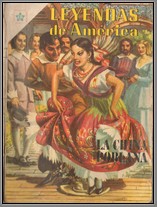Mexico
1961 Mexican comic book on Leona Vicario. Binding weak. M (Mexico)
Price: $90.00
Note: 'María de la Soledad Leona Camila Vicario Fernández de San Salvador', best known as 'Leona Vicario', was one of the most prominent figures of the Mexican War of Independence. She was dedicated to informing insurgents of movements in her home Mexico City, the capital of the viceroyalty.
 CEP 245
CEP 245 CEP 245
CEP 245 CEP 245Collection of ten 19th century illustrations of life in Mexico, from English periodicals. Shown are street scene in Mexico City, taking fruit to market, local costumes, exterminating the Yaquis in 1905, view of Vera Cruz, recall of Santa Ana to Mexico, travelling between Vera Cruz and Mexico City, cartoon of Mexico as “our rooster”, view of Acapulco, location of where Maximillian was shot, more. B
CEP 245Collection of ten 19th century illustrations of life in Mexico, from English periodicals. Shown are street scene in Mexico City, taking fruit to market, local costumes, exterminating the Yaquis in 1905, view of Vera Cruz, recall of Santa Ana to Mexico, travelling between Vera Cruz and Mexico City, cartoon of Mexico as “our rooster”, view of Acapulco, location of where Maximillian was shot, more. B
Price: $300.00
 CEP 245 CEP 245 |  CEP 245 CEP 245 |  CEP 245 CEP 245 |  CEP 245 CEP 245 |
 CEP 245 CEP 245 |  CEP 245 CEP 245 |  CEP 245 CEP 245 |  CEP 245 CEP 245 |
 CEP 206Mexican comic book La China Poblana, 1958. It is the story of Catarina de San Juan. Cover wear, one page repaired. M
CEP 206Mexican comic book La China Poblana, 1958. It is the story of Catarina de San Juan. Cover wear, one page repaired. M
Price: $90.00
Note: Catarina de San Juan known as the China Poblana was a slave that, according to legend, belonged to a noble family from China. She was brought to Mexico through the Spanish East Indies (Philippines), and has been credited since the Porfiriato with creating the China Poblana dress. After converting to Catholicism in Cochin —a city where she was kidnapped by Portuguese pirates—, Mirra was given the Christian name Catarina de San Juan, the name she was known as in Angelópolis where she worked as a slave, got married, and eventually became a beata - a religious woman who took personal religious vows without entering a convent. Upon her death, Catarina de San Juan was buried in the sacristy of the Templo de la Compañía de Jesús in Puebla, in what is popularly known as Tumba de la China Poblana or Tomb of the Chinese Pueblan. (Note that in Hispanic cultures at the time it was common to use the term chino to refer to all persons of Asian descent, regardless of actual ethnicity.)


















